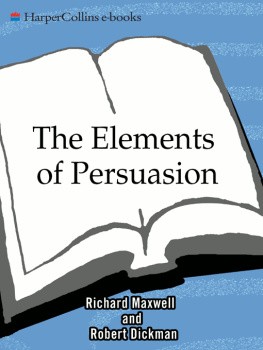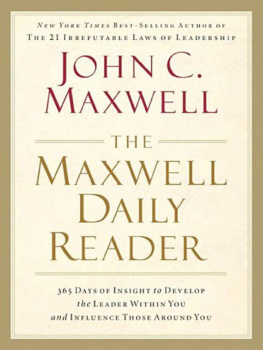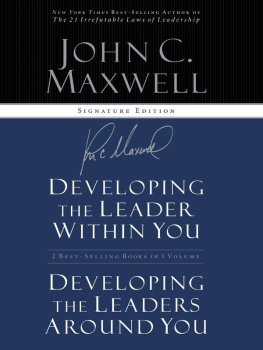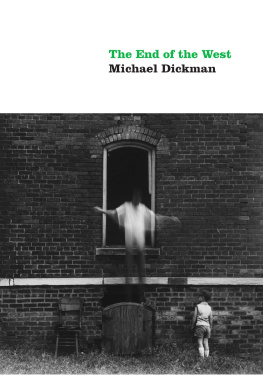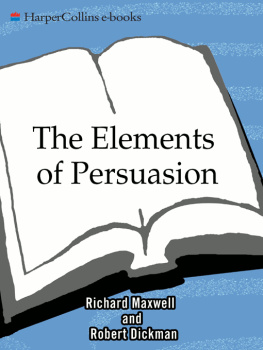T here are two things everyone in business does every day. We all sell somethingour products, our services, our skills, our ideas, our vision of where our business is goingand we tell stories. We sell things because that is how we as a democratic, capitalist society organize our energy. We tell stories because, as cognitive psychology is continuing to discover, stories are how we as human beings organize our minds. If we want to sell something, we have to persuade someone else to buy it.
We didnt always put such a high premium on persuasion. There was a time when the biggest and toughest among us simply told the smaller and more delicate what to do and punched them in the nose if that were a problem. Everyone, with the possible exception of Mike Tyson, agrees our modern way is better. But it has required us to learn a whole new skill set.
Compared with our great-grandparents, even the least skilled among us are crackerjack salespeople. It comes from practice.
One hundred years ago we didnt get much. Most of us lived on more or less self-contained farms. Our business was agriculture, controlled by slow seasonal rhythms. We sold our harvest once or twice a year. We got the market price. We hitched up our buckboard and rode into town once or twice a month and shopped at the general store. What we got there was largely generic. We wanted biscuits, but the type of biscuit we got was the type the store sold. Limited shelf space and the difficulties of transportation made brand options rare. We might try a new product, if the store clerk took the time to tell us how it was improved and how many satisfied customers he had, or we might not. Then, having completed our relatively intense commercial experienceintense enough so that going to the store was considered not a chore but entertainmentwe headed back to our farm and our normal daily routine, secure in the knowledge that for the next week or so we wouldnt have to either buy or sell anything.
This left us easy marks for anyone who really knew how to deliver a sales pitch. Which is one of the reasons traveling salesmen got the reputation they gotand why some of us still feel slightly embarrassed about being in sales. When the telephone reached out to even the most distant farms we resented it and called the salesmen who used this new medium to catch us around the dinner table phonies. The name stuck.
Admittedly things werent so leisurely paced if you lived in the slums of New York, and if you are reading this in Europe you will have to adjust the dates back one or two hundred years, but you get the idea. Buying and selling used to be an occasional thing.
Compare that with how many times you were involved in a sales pitch just on your way to work today. The newspaper ads your eyes skimmed past (but which had their subliminal effect), the radio spots that interrupted the news on your morning drive, the focus-group-tested sound bites the politicians used to push their parties agendas (or, if your radio tastes are different, the product-placement mentions of burgers and beverages by your favorite rap artist), the billboards, the bumper stickers, the product logos on T-shirts. And they arent just selling products. They are selling ideas, opinions, brand loyalties, political affiliationsyou name it. Persuasion is very big business.
How big? In 1999, economist Deirdre McCloskey, writing in the American Economic Review, estimated that 28 percent of the GNP of the United States was involved in commercial persuasion. This includes law, public relations, the ministry, psychology, and marketing. That means last year almost $3.3 trillion was spent in the United States on commercial persuasionselling.
Think about that $3.3 trillion. That makes the country of persuaders the third-largest economy in the world.
To deal with all that persuasive pressure, to have even a few meager dollars in our pockets at the end of the day, we have all had to develop tremendous sales resistance. To keep from being overwhelmed and paralyzed by all the demands that we do this or buy that, we have developed thick skins and the ability to ignore most of the chatter. For those of us whose business depends on being able to persuade otherswhich is all of us in businessthe key to survival is being able to cut through all that clutter and make the sale.
The good news is that the secret of selling is what it has always beena good story. Its that simple. Stories sell.
The even better news is that storytelling is innate in the human psyche. It is something we all know how to do.
In fact, it is so hardwired into us that it has its own place on our genomea gene called FOXP2 . Discovered in 2001 by Professor Anthony Monaco and his research team at Oxford University, FOXP2 is now thought to be only the first of what scientists believe is a whole constellation of genes that make language and narrative possible. FOXP2 specifically makes possible the subtle physical and neurological skills needed to speak words rapidly and precisely, and is probably linked to the use of complex syntax as well. From a cellular level on up, we are all born storytellers.
So if we all can tell stories, and stories are crucial to selling, why are some of us better at selling our products and ideas than others?
Its a lot like running. We all know how to do it, but only a few of us will ever break a four-minute mile. What separates the great runners from the also-rans is that great runners understand how to run from the inside out . They know how every stride, every muscle in that stride, fits together to achieve the goal. If we want to excel at persuasion, we need to understand story that same way.
The problem is that we are bombarded by so many stories every daystories about what toothpaste is best, about terrorists lurking in the shadows, about new scientific discoveries and eternal spiritual truthsthat it is hard to focus on story as story. To see a story for what it is rather than what it is about. We need to get stories to hold still long enough for us to get a good look at them. For that, we need a good definition.
The definition we will use throughout this book is a simple one:
A story is a fact, wrapped in an emotion that compels us to take an action that transforms our world.
In the early 1970s Jerome Bruner, one of the fathers of modern cognitive psychology, was closely observing very young children. He noticed, and soon proved, that even before children are able to talk they are organizing their world and communicating by simple stories.
First are what he called the stories of completion. The young child says (by means of gesture and facial expression), All gone, when the bottle is empty. The child says, Uhoh, when she feels she has made a mistake and Ohh! when surprised or pleased.
These stories are short but complete. And they meet our definition. Take All gone. The fact is that the bottle is empty. The baby wraps this fact in an emotioneither satisfaction or desire for moreand expresses that. Depending on which emotion is expressed, the parent is compelled to take an actioneither to burp the baby and settle her down, or to get another bottle. Either way, the babys world has been transformed for the better. Bruner went on to assert that infants develop meaning through narrative, and that the need to create stories precedes language. He even suggests that infants are motivated to learn to speak precisely because they already have stories inside themselves that they want to share with others.

